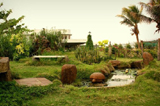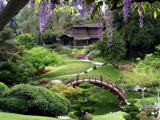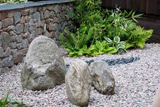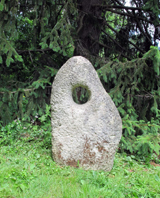Soul
Gardening for the soul
Landscape design, beauty and spirituality
Abstract
This article outlines the healing journey one sadhak experienced in labouring to provide a place of beauty, serenity, and reflection for the benefit of others at the Park Guest House in Pondicherry. It is suggested that, in a similar way, anyone who gardens can (and probably already does!) gain wonderful benefits.
Inspiration through yoga
This is a story of healing through connection with nature, focusing on elements of landscape design and being guided by the Integral Yoga. It all began initially as part of my sādhanā here at the Sri Aurobindo Ashram at Park Guest House. It fell to me at a certain point to take over the care of the seaside garden. As a creative person and nature lover, I found this escape outdoors in a garden to be a perfect opportunity. Only slowly did the work begin to take a life of its own.
Reading through the works of Sri Aurobindo and the Mother on nature and beauty, I was inspired to investigate a little deeper into the subject. My exploration made me study various books on gardens and landscaping. I realised that the garden is a condensation of the universe; it is a place of natural beauty. Here one could relate in a compassionate way to the living land, the rocks, plants, water and soil. The garden also teaches us an appreciation for the unseen in dealing with the energy of the land and with the power of the earth itself. Here is a place where things constantly change with growth and decay.
After working for a while in the garden I had a major breakthrough. I came to realise that I was very fond of nature and natural things. Being in nature was very soothing and it brought about a refinement in my being. My nature’s rough edges were polished and smoothened. Also I felt that here I could be most effective in helping to change the world, particularly in terms of humanity’s relationship with nature. In fact what I learnt later in the garden went far beyond gardening and embraced all activities. I also realised how with the growth of the garden I too spontaneously grew.
My search was to understand nature by directly participating in it as intimately as I could. Movement, change, light, growth and decay are the life-blood of nature. Nature is in a state of change and that change is the key to understanding.
Reading a few lines of the Mother, I realised the importance she laid on nature and its power and relevance for spiritual life:
“When you have nothing to do, you become restless, you run about, you meet friends, you take a walk, to speak only of the best; I am not referring to things that are obviously not to be done. Instead of that, sit down quietly before the sky, before the sea or under trees, whatever is possible (here you have all of them) and try to realise one of these things — to understand why you live, to learn how you must live, to ponder over what you want to do and what should be done, what is the best way of escaping from the ignorance and falsehood and pain in which you live (1).”
This became my way of works over time, both in the garden and inside myself. For me, labouring in the garden was actually for the benefit of the guests, and everything fits into a plan of creating a healing space for them. It was only much later that I really understood — I had truly benefited more than any guest ever could have! I would like to share some of the significant aspects of this journey of healing in the garden.
Gardening, I had known, was a physical and creative activity; it draws on the intellect as well as the emotion. My approach to gardening was the naturalistic one, which reveals the organic side of the garden. I decided to use eco-friendly garden solutions and products; it wouldn’t make sense to drown it in chemicals such as pesticides (insecticides) and fungicides, etc. I would stick to the natural effects and totally avoid artificiality so that the visitors would feel the closeness to nature. By giving nature its freedom, I realised that I had opened myself to the new relationships that nature would suggest.
The living garden is always in a process of change, as plants grow and blend more and more together, as our understanding deepens and we see things in the garden that we had not seen before or had not understood deeply enough. The garden grows and becomes richer, more subtle in its expansion. You feel and experience ‘silence’, the inner being in you. It is so fluid that it vibrates with a kind of relaxation. The garden takes time to make, but it has a rewarding beauty.
This garden would be a synthesis of Indian ideas and the traditions of Japan where the Japanese intend to imitate the intimate essence of nature, not its actual appearance and to serve as an aid to meditation about the true meaning of life.
Japanese gardening is very subtle. What they really do is to suggest Nature, to symbolise Nature in all her vastness, by means of a rigorously selected, meticulously placed small number of garden plants and stones that are pregnant with spiritual associations. They believe that nature is not ornamental. These gardens — characterised by stones, water, unusual plants and minimal amounts of colour — are traditionally designed to promote inner peace and serenity. They eliminate everything which is not essential for its beauty.
The garden is very close to the ocean. The haunting and impelling beauty of the seaside is deceptive; the elements can also be cruel and destructive. I realised that low-growing plants would help keep the panoramas visible. To add to the difficulty, many plants that prosper in other parts of Pondicherry could not survive here. It is all due to the salty ocean breeze. The solution to this conundrum was choosing plants that could adapt to the rigours of this climate. Moreover a feeling of spaciousness comes from limiting the number of plants!
The Mother, in one of her talks to the children, says, “On the physical plane it is in beauty that the Divine expresses Himself... In the physical world, of all things it is beauty that expresses best the Divine. The physical world is the world of form and the perfection of form is beauty. Beauty interprets, expresses, manifests, the Eternal. Its role is to put all manifested nature in contact with the Eternal through the perfection of form, through harmony and a sense of the ideal which uplifts and leads towards something higher (2).”
Here she has described what has been a central guiding principle in designing and maintaining the guesthouse garden. And the value she places on flowers as a doorway to the psychic being is understood by most who know of her. She says:
“Love of flowers is a valuable help for finding and uniting with the psychic. …Since flowers are the manifestation of the psychic in the vegetal kingdom, love of flowers would mean that one is drawn by the psychic vibration and consequently by the psychic in one’s own self. When you are receptive to the psychic vibration, that puts you in a more intimate contact with the psychic in your own self. Perhaps the beauty of flowers too is a means used by Nature to awaken in human beings the attraction for the psychic (3).”
There are of course elements of landscape design other than flowers and foliage which are used to evoke the power and energy of healing. For example, in our garden, I felt its ‘gardenness’ did not stop with the plants. I experimented, creating landscapes with local materials, slabs of stones and granite, setting each piece with my own hands. The challenge was to create landscapes that look as if they have always existed. Natural rocks and stones possess qualities that are both pleasing to the eye and gratifying to the soul. Stones radiate a sense of timelessness, a solidity and presence. They were created thousands of millions of years ago. Their strength and huge variety of colour and texture make them very special.
The flow of water is another deeply satisfying element in a garden. The sound of falling water is an ancient way of focusing the mind in order to let go of stress and problems that plague everyday life. In this meditative garden, the sound of water becomes a vital aid in learning this relaxation skill and helps the mind become so tuned in, that distractions are less likely to interfere with our concentration. The natural trickle of the water flow is far more appealing than heavy falls that tend to mask birds and other natural sounds that users find appealing. Gazing upon the rills of water and the small pool provide visual inspiration and a fluid coolness all summer long.
Beauty
Another aid for inner reflection here is carved or painted inscriptions. These can be provocative, propounding perhaps a philosophical idea or inducing a smile! Calligraphy is a most beautiful art which is fully developed when the choice of lettering style reflects the provenance of the inscription. Gardens are places to stimulate the senses and memories. How gratifying, then, to be reminded of a favourite line while meandering through the garden!
Sculptures are used here for the same purpose. They can take many forms, and their beauty and healing power are dependent upon the quality of materials and the skill of the craftsman. A carefully chosen and positioned piece of sculpture can entirely refocus a garden design, giving a lifetime of pleasure. ‘Objets-trouvés’ can create an atmosphere inviting contemplation. The earth, rocks, stones and boulders are symbols of the unchanging, the ultimate reality, the deities. Stones also symbolise the Absolute, the realm of the ancients.
The Mother has said, “To do this yoga, one must have, at least a little, the sense of beauty. If one does not, one misses one of the most important aspects of the physical world.
There is this beauty, this dignity of soul — a thing about which I am very sensitive. It is a thing that moves me and evokes in me a great respect always (4).”
Love and respect
In having reverence and respect for the earth, we enrich our spiritual journey. Without it, the journey is incomplete. When we garden with understanding and acknowledgement we realise it as a place of growth not only for nature but for our inner selves. In this spiritual space we consciously restore the meaning of what might otherwise be considered ordinary work: digging, planting, watering and maintaining the space. As we gain understanding of the spirit in matter and in all things, we better appreciate the importance of cooperation within natural systems as well as among people. Too often, we have lost that connection to the natural world and our awareness of our place in it and our responsibility to nurture it. If we truly care for ourselves, our families, our friends and communities, then we must also show that loving attention, thoughtfulness, and protection for the living earth. We go to these places, not always to work but to come into contact with the spiritual essence of nature. These spaces truly help us as seekers to live more meaningful and dedicated lives.
Gardens are very important to the health of the environment and for the enrichment of human life. Moreover, from the viewpoint of taste, they serve as a mirror reflecting the pleasures of the vast world of nature. In this area one can also move leisurely, admiring the various views and exchanging tasteful conversations.
In these spaces we also learn that there is a large pattern of the cycle of life that is beyond our control. We learn patience from the long wait from planting to sprouting to blooming, as we learn acceptance when nature takes its own course. We gain humility when we come across a certain complexity of the natural world. Seeing becomes understanding — the Divine’s presence is easily seen in His handiwork. Mistakes and experiments were made but they always taught me something. Experiments for a useful, productive end, part of a forward movement of life. There were also many trials and errors before the garden reached its present form.
In the garden we can truly sense an acute feeling of being one with nature in a complete way, a sense of awe and wonder. Love seems to be a priority when one starts working in the garden. Also loving and accepting every aspect of ourselves, we become whole. We begin to experience the compassion that allows us to feel and understand the essence of all forms of life. Once we accept that all life is interrelated it becomes obvious that every one of our actions has an effect on nature, no matter how far removed those actions may be from a garden.
One of the most significant aspects of contact with a garden is simply that it helps to enlarge our viewpoint. If we treat everything as alive, our own life is greatly enriched. In a garden very often one feels that one is part of the whole — part of that clod of earth, part of that tiny flower, part of the rain and sunshine.
Conclusion
In closing, I have realised that the garden draws visitors who have had good experiences and gone away renewed. Upon entering the garden, a sense of reverence is called forth, asking for silence and respect. If we heed this signal we may find ourselves rewarded with something hallowed, healing, and special! I have also realised that the quality of that transmission is conditioned by the clarity and character of the receiver. An unexpected realisation has been the degree to which my own life and inner harmony and healing have been enriched more than those of the myriad guests who come and go. Working here is always a means to express oneself, to develop one’s capacities and possibilities and also offer service to the whole community. Let me thus serve the Ashram and humanity humbly, fulfilling my presence in this world with loving kindness.
We’ll conclude here with a few lines by the Mother from her Prayers and Meditations:
“At these blessed hours all earth sings a hymn of gladness, the grasses shudder with pleasure, the air is vibrant with light, the trees lift towards heaven their most ardent prayer, the chant of the birds becomes a canticle, the waves of the sea billow with love, the smile of children tells of the infinite and the souls of men appear in their eyes (5).”
References
1. The Mother, Collected Works of the Mother, Volume 3. Cent. ed. Pondicherry: Sri Aurobindo Ashram Trust; 1979, p. 251.
2. The Mother, Collected Works of the Mother, Volume 12. Cent. ed. Pondicherry: Sri Aurobindo Ashram Trust; 1979, p. 234.
3. The Mother, Flowers And Their Messages. Pondicherry: Sri Aurobindo Ashram Trust, 1992, p. vii.
4. The Mother, Collected Works of the Mother, Volume 15. Cent. ed. Pondicherry: Sri Aurobindo Ashram Trust; 1979, p. 373.
5. The Mother, Collected Works of the Mother, Volume 1. Cent. ed. Pondicherry: Sri Aurobindo Ashram Trust; 1979, p. 356.
Devashish Patnaik has been serving at Park Guest House, Pondicherry for the past 30 years.
Share with us (Comments,contributions,opinions)
When reproducing this feature, please credit NAMAH,and give the byline. Please send us cuttings.






